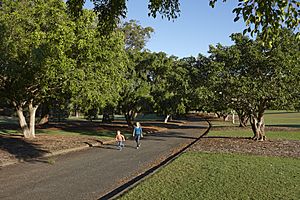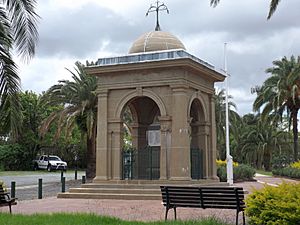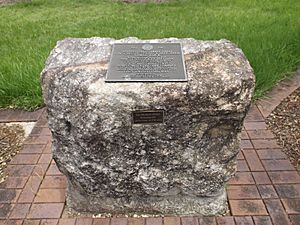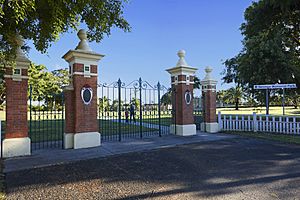Yeronga Memorial Park facts for kids
Quick facts for kids Yeronga Memorial Park |
|
|---|---|

Honour Avenue in Yeronga Memorial Park
|
|
| Location | Ipswich Road, Yeronga, City of Brisbane, Queensland, Australia |
| Design period | 1870s – 1890s (late 19th century) |
| Built | 1882 |
| Owner | Brisbane City Council |
| Official name: Yeronga Memorial Park | |
| Type | state heritage (landscape, built) |
| Designated | 2 December 2005 |
| Reference no. | 602462 |
| Significant period | 1917–1960s (fabric) 1882, 1888, 1917–1921, 1942–1945 (historical) 1882-ongoing (social) |
| Significant components | memorial – pavilion, trees – remnant scrub, wall/s – retaining, tree groups – avenue of, memorial – rock/stone/boulder, hall – cwa, memorial – swimming pool, trees/plantings, croquet lawn, road/roadway, clubroom/s / clubhouse, memorial – gate/s, memorial – tree/avenue of trees, bowling green, hall – scouts / guides, terracing, oval/sports field, shed/s, pathway/walkway |
| Lua error in Module:Location_map at line 420: attempt to index field 'wikibase' (a nil value). | |
Yeronga Memorial Park is a special park in Yeronga, Queensland, Australia. It's a very old park in Brisbane, started in 1882. Since 1917, it has also been a memorial for World War I. The park covers about 22.46 hectares (55 acres). It was added to the Queensland Heritage Register in 2005 because of its important history.
Contents
Discovering Yeronga Park's Past
Yeronga Memorial Park is surrounded by Ipswich Road, Villa Street, Park Road, and School Road. The park's story shows how Yeronga grew. It also reflects important events in Queensland's history.
Early Days and First People
Before Europeans arrived, the Jagera tribe lived in this area. They continued to use the land even after a convict settlement began in Brisbane in 1824. Later, Europeans used the land for sheep farming.
How Yeronga Park Began
The Ipswich Road became a main route to the inland. In the 1860s, this rough track was surveyed. The first land sales in Yeronga happened in 1854. People started farming crops like cotton and potatoes. In 1879, the Queensland Government set up local councils. Yeronga was part of the Yeerongpilly Division.
In 1882, the Yeerongpilly Divisional Board made 41.9 hectares (103 acres) of land a public park. In 1886, the Stephens Division was created. This new area included Yeronga and the park. In 1888, the Stephens Division made 41.74 hectares (102 acres) of the park a permanent reserve.
Growing with Transport Links
Yeronga started to grow when the railway line opened in 1884. This link made Yeronga a popular place to live. By the 1890s, many grand homes were built here. In 1903, the Stephens Division became Stephens Shire. Yeronga grew even more when the tramline reached Yeronga Park in 1915.
Changes to the Park's Size
Yeronga Memorial Park is one of Brisbane's oldest parks. It started as a large reserve. However, its size has changed over time. Parts of the park were used for other things. For example, some land was used for the railway line in 1888. Other parts became Villa Street in 1902 and 1912. In 1919, some school land was added to the park to create Honour Avenue.
More land was taken for the Yeronga Fire Station in 1930. A sports oval was built in 1931. In 1950, land was used for the Yeronga Kindergarten. The Yeronga State High School was built in 1960. Today, the park covers 22.46 hectares (55 acres).
Remembering Our Heroes: War Memorials
One of the most important parts of Yeronga Park is its role as a World War I memorial. This began between 1917 and 1921.
Honour Avenue: A Path of Remembrance
Around 1917, a road was built through the park. This road became Honour Avenue. Between 1917 and 1919, 96 weeping fig and flame trees were planted along this road. Each tree had a timber post with a metal shield. The shield showed the name of a soldier from Stephens Shire who died in the war. Having a named avenue of memorial trees in a park is special in Queensland. This memorial avenue is one of the earliest in Australia.
Memorial Gates and Pavilion
In 1921, a memorial pavilion and two sets of memorial gates were built. The gates stand at each end of Honour Avenue. The pavilion is a bit off to the side. However, a path lined with palms connects it to the other memorials. The domed shape of the pavilion is uncommon for war memorials. The dedication on the Ipswich Road Gates is also unusual. It honours the women workers of Stephens Shire.
Australia felt great sadness after 60,000 servicepeople died in World War I. Most of them were buried overseas. This led to many memorials being built across the country. Of the 559 people from Stephens Shire who joined World War I, 97 names are carved into the memorial pavilion. The original shields by the trees are gone. However, new name plates are now set in concrete at the base of the trees. Some plaques are also placed on other trees near the Ipswich Road gates.
After Greater Brisbane was formed in 1925, the Brisbane City Council took over managing Yeronga Park.
World War II and Beyond
During World War II, American military units used Yeronga Park. Aerial photos from 1946 show many huts built for these troops. Not much physical evidence of this remains today. Part of the Girl Guides hall might be from this time. The American Legion has placed a memorial stone near the pavilion. It remembers the American forces who used the park during World War II.
In 1979, a plaque was added to the Park Road gates. It remembers people from the area who served in World War II, the Malayan Emergency, the Indonesia–Malaysia confrontation, and the Vietnam War.
Activities and Facilities in the Park
Yeronga Park has always been a place for sports and recreation. Many clubs have used parts of the park over the years.
Sports and Clubs
The Yeronga Tennis Club started in 1909. It still uses three courts near Villa Street. The Stephens Croquet Club began in 1923. They built a wooden clubhouse and two croquet lawns. The Annerley Bowls Club operated from 1927 to 1992. Their brick clubhouse is now used by the Brisbane Bridge Centre.
In 1936, a large in-ground draughtsboard was built. It was resurfaced in 2003. The shale stone wall along Ipswich Road was built in the mid-1930s. This was likely a project during the Depression to create jobs.
Yeronga Park Memorial Swimming Pool
The Yeronga Park Memorial Swimming Pool Complex was built between 1960 and 1964. It has an Olympic pool and two wading pools. A heated pool was added by 1972. This pool complex is a type of war memorial that became popular after World War II. Useful structures like pools and hospitals were seen as good ways to remember. The Southern Districts Rugby Football Club started using the park in 1970. Their clubhouse was built in 1986.
Other Groups in the Park
Other groups also have buildings in the park. The Kurilpa Scouts use the Baden Powell Memorial Hall. The Yeronga Girl Guides have a building further east. The Queensland Country Women's Association (CWA) built their headquarters in 1952. Some other buildings like the Yeronga Fire Station were built on land that was once part of the park.
What You Can See in Yeronga Park Today
Yeronga Memorial Park is bordered by Ipswich Road, Villa Street, Park Road, and School Road. Honour Avenue, a bitumen road, crosses the northern part of the park. It has weeping figs planted on both sides. Honour Avenue divides the park into two main areas. The northern part has older sports facilities. The southern part has native trees and newer sports areas.
Memorial Gates and Pavilion
At the western end of Honour Avenue are the memorial gates at Park Road. They are made of red brick with smooth corners. They have iron gates for vehicles and people. A metal plaque on one pier remembers those who served in World War I. Another plaque remembers those who served in World War II and other conflicts.
The Ipswich Road memorial gates are more decorative. The inner two piers are taller. They also have low brick walls. A special plaque on the northern gate reads: "These gates were erected by the women of Stephens Shire in honour of the men who fought for them." The southern plaque is dedicated to the "women workers of Stephens Shire."
The World War I memorial pavilion is near the old bowling clubhouse. It is a square concrete building with a domed roof. Inside, a polished stone pillar lists the names of those who died from Stephens Shire in World War I. A small stone flaming urn sits on top of the pillar. A World War II memorial stone is located west of the pavilion.
Sports and Club Facilities
North of Honour Avenue, you'll find several facilities. These include a Scout hall, three tennis courts, and a Girl Guides hall. There are also two unused bowling greens at different levels. A brick shed stands south of the upper bowling green.
The Scout hall is a long, rectangular building made of timber. The Girl Guides hall has an older timber section and a newer concrete block part.
The Stephens Croquet Club has several croquet greens and a clubhouse. The clubhouse is a small, rectangular timber building with a corrugated iron roof. It has old multi-paned windows.
A large in-ground draughtsboard is located between the old Bowling Club and Honour Avenue. A stone wall runs along Ipswich Road. This wall forms a raised area south of the memorial gates. There is a cricket oval southwest of the rugby field. The Country Women's Association (CWA) rooms face School Road. The CWA building is a simple timber cottage. Another cricket oval is located between the Swimming Pool Complex and Honour Avenue.
Swimming Pool Complex
The Swimming Pool complex is in the southwest corner of the park. It includes changing rooms, a kiosk, an Olympic-size pool, two small wading pools, and a 25-meter heated pool. The wading pools have shade structures. The pool complex is fenced, and you can enter from School Road. A bitumen carpark is next to Yeronga State School.
Trees and Green Spaces
The park has many mature trees. These include eucalyptus woodland near the swimming pools. The weeping figs along Honour Avenue are special memorial trees. Other mature figs are planted along Ipswich Road and School Road. There are also Canary Island date palms and Chinese fan palms throughout the park. These trees add to the park's beauty.
Park Facilities
Yeronga Park offers many facilities for visitors. It has the Yeronga Park Heated Pools, a beach volleyball area, and a Swimming Club. There are also tennis courts, lawn bowls greens, and cricket fields. The Brisbane City Council runs a 50-meter swimming pool complex on the park's southern edge. The Swimming Club started in 1965.
Why Yeronga Memorial Park is Special
Yeronga Memorial Park was listed on the Queensland Heritage Register in 2005. This means it is a very important place.
Showing Queensland's History
The park helps us understand Queensland's history. It was a recreation reserve from 1882. Later, it became a memorial park in 1917. The park's design, buildings, trees, and activities show many important historical themes. These include sports activities since the 1880s, like blind cricket, bowls, and croquet. It also shows the history of Boy Scouts and Girl Guides. The park served as a World War I and World War II memorial. Building the stone wall along Ipswich Road also provided jobs during the Great Depression.
Unique and Important Features
The memorial avenue with trees, memorial gates, and memorial pavilion were created between 1917 and 1921. These are key parts of the park. They show the sadness and remembrance felt across Stephens Shire and Australia after World War I. Most communities in Queensland built memorials to honour those who served. Each monument is a unique historical record. The honour avenue is one of the earliest World War I memorial avenues in Australia. The domed memorial pavilion is an uncommon type of war memorial in Queensland. The dedication on the Ipswich Road memorial gates, which honours the women workers of Stephens Shire, is also very unusual. It publicly recognizes the important role women played in World War I.
Key Characteristics of the Park
Yeronga Memorial Park shows the main features of a public park and a war memorial. Much of the park's layout from 1917 still exists. Important elements include the tennis courts, croquet clubroom and lawn (1923), and the palm-lined path. The bowling greens (1927), the in-ground draughtsboard (1936), the memorial pavilion (1921), and the memorial gates (1921) are also key features. South of Honour Avenue, you can find the CWA hall (1952) and the Memorial Swimming Pool Complex (1960–1964). The shale stone wall along Ipswich Road (1930s) and native eucalyptus trees are also important.
Many individual features are great examples of their type. These include the timber Croquet clubroom, the bowling greens, the memorial gates, the memorial pavilion, and the Memorial Swimming Pool Complex.
Beautiful and Scenic Views
Yeronga Memorial Park is also important for its beauty. The large and impressive memorial gates create a dignified entrance to Honour Avenue and the memorial pavilion. The shale stone wall along Ipswich Road is a pretty feature. The many trees mixed with open sports areas create pleasant views within the park. This is especially true between the croquet club and tennis courts, and across the central cricket oval. The croquet clubroom and the brick building near the upper bowling green also add to its beauty. The park also makes the streetscape along Ipswich Road look better.
The mature trees that make the park beautiful include: the memorial fig trees along Honour Avenue, the memorial palms, the cypress trees around the tennis courts, and the eucalyptus woodland near the swimming pools.
Strong Community Connection
Yeronga Park has a strong and ongoing connection with the local community. It is a memorial to those who died in war. It has also been used by sports groups for a long time. Its presence as a landmark on Ipswich Road makes it socially important to the area.




